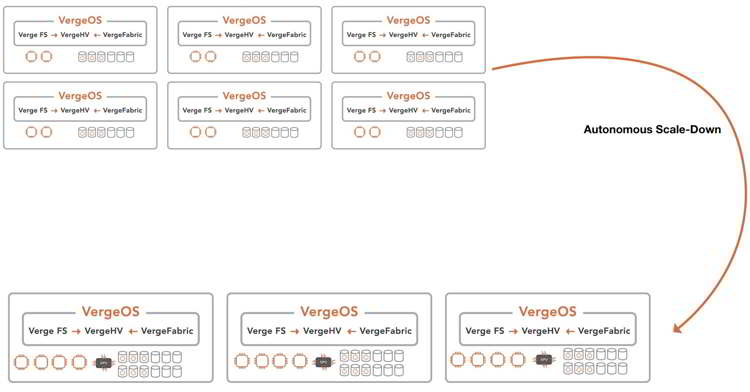VergeIO ioOptimize to Maximizing Performance, Resilience, and Sustainability for Virtualized Environments
Extends lifespan of IT hardware by employing VergeOS to support multiple-gen of CPUs, various storage media, and diverse network hardware simultaneously.
This is a Press Release edited by StorageNewsletter.com on October 31, 2024 at 2:02 pmVergeIO, Inc. announced ioOptimize, an integrated service of VergeOS featuring ML and narrow AI.
 This service is crafted to boost VergeOS’ flexibility, enabling servers to provide dependable service long beyond their expected lifespan. With ioOptimize, organizations can utilize VergeOS without being tied to specific hardware, thus offering customers increased flexibility and control over their IT environments, all at no extra cost.
This service is crafted to boost VergeOS’ flexibility, enabling servers to provide dependable service long beyond their expected lifespan. With ioOptimize, organizations can utilize VergeOS without being tied to specific hardware, thus offering customers increased flexibility and control over their IT environments, all at no extra cost.
ioOptimize extends hardware longevity
The company’s ioOptimize extends the lifespan of IT hardware by employing VergeOS to support multiple-gen of CPUs, various storage media, and diverse network hardware simultaneously. Customers can mix new and older nodes from different vendors, enabling them to create an environment where servers of varying ages operate together seamlessly. By automatically migrating VMs from aging or failed servers to more capable nodes, ioOptimize ensures smooth, uninterrupted operation.
“As our customers’ servers age, ioOptimize steps in to manage workload placement and automatically migrates VMs when needed, minimizing downtime due to hardware failures,” said Greg Campbell, CTO. “This level of resiliency ensures organizations get the most out of their hardware investments.”
Rapid hardware innovation adoption
ioOptimize helps VergeOS customers to stay ahead of the competition by rapidly incorporating new hardware innovations. Unlike traditional solutions that require hard-coded updates for new hardware, it dynamically learns and adapts to new hardware capabilities. For example, customers upgrading from 10GbE to 25GbE network cards benefit from ioOptimize’s ability to instantly leverage increased bandwidth and active-active ports, ensuring seamless network performance.
Automated Scale-Down feature
With the release of VergeOS 4.13, ioOptimize introduces an ‘automated scale-down’ feature. As VergeIO’s unique licensing is per server rather than per CPU or core, this feature enables customers to reduce server count while increasing capacity. For example, organizations using 12 dual-processor nodes may transition to 8 quad-processor servers with increased performance and capacity.
ioOptimize migrates VMs and data from older hardware to new, denser servers, reducing power, cooling, and space requirements. Once the migration is complete, VergeOS notifies administrators, enabling them to power down older servers and streamline their data center operations.
Lower TCO, sustainability benefits, and unrestricted licensing
ioOptimize helps organizations lower the TCO by enabling them to consolidate hardware, decrease energy consumption, and reduce data center footprints. This directly supports sustainability initiatives, allowing enterprises to achieve their environmental goals through a more energy-efficient IT infrastructure. Fewer servers result in lower energy use, reduced carbon emissions, and more cost-effective operations.
Unlike traditional licensing models, which penalize organizations for deploying high-density, quad-processor servers with triple-digit cores, VergeIO’s licensing frees customers to adopt more powerful servers without incurring additional costs. Competing models restrict an organization’s ability to meet sustainability goals, imposing higher costs for using efficient hardware. With the firm’s server-based licensing, customers can implement dense, robust systems that reduce power consumption, cooling needs, and data center footprint, aligning their infrastructure with financial and environmental objectives.
“Hardware vendors have been focused on assisting organizations, helping them reduce their data center costs while achieving sustainability goals. Unfortunately, too many software vendors hamper those efforts because of their per-core and per-capacity licensing models. These models discourage, rather than encourage, customers to invest in denser, more efficient hardware platforms that lower rack space, power, and cooling expenses,” said Marc Staimer, president, Dragon Slayer Consulting. “VergeIO’s per sever licensing model is a rare exception to this trend. Their willingness to help customers significantly shrink their data center footprint is exactly what IT professionals need.”
Resource:
Blog: Why Do Data Centers Still Rely on Dual-Processor Servers?















 Subscribe to our free daily newsletter
Subscribe to our free daily newsletter


